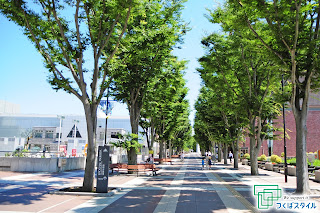Urban space planned, expected and abandoned
つくばセンタービル
磯崎新さんが設計した都市空間です。
1983年6月10日にオープンしています。
筑波科学万博の開催が1985年なので、つくばセンタービルが誕生したのは、これからまさに筑波研究学園都市の周辺一帯が発展していくだろうと予感されて活気づいていた時期です。
磯崎新さんは、1985年に「未来都市つくば」という水彩画を発表しています。
そこに描かれているのは「廃墟」でした。
つくばセンタービルの設計は、未来の廃墟を見据えていたのでしょうか。
カンピドリオ広場がモチーフ
つくばセンタービルの広場は、イタリア・ローマのカンピドリオ広場がモチーフになっています。

カンピドリオ広場を反転させたような、低い場所に噴水を中心に据えた設計です。
#仮面ライダーロケ地巡り#スーパー戦隊ロケ地巡り#特撮ロケハン部— yuui (@knd_kirikatsu) 2017年7月3日
場所:茨城県つくば市。つくば駅そばつくばセンタービル広場。
登場作品:多数の東映特撮作品
先ほどあげましたがちゃんとした形で再掲。
有名な場所なので、知ってる方も多いかと。#nitiasa pic.twitter.com/vNlXQSkJvX
とにかく広大な空間
筑波科学万博は一年足らずの開催期間。
でも、まるで万博が続いているのかというくらいに、その後10年くらい、つくばセンタービル界隈は活気に満ちて賑わっていたように記憶しています。
当時、子供の目には、とにかく広大な空間に感じられました。
記憶そのものが薄らいで、もはや思い出の中でしか会えない光景です。
むしろ、薄らいでいるからこそ、美しい光景に感じることができるのかもしれませんが。
未来的で、若々しさにあふれている空間だったのです。
でもそれは、なんだか自分たち自身のようにも思えてしまうことがあります。
生まれたての街を、生まれたばかりの子どもが歩いている。
将来を期待されて、泣いても笑っても、あるがままの成長を喜ばれて。
ほどなく反抗期、思春期。
かわいがられた子どもたち。
にくたらしくなっていく姿。
期待してくれた大人たちが、
「(・д・)チッ」と舌打ちするような、
そんな大人へと変貌していく。
成人式の華やかさも賑やかさも、まるで幕引きのように。
それでも、愛されているのであればなんの問題もありません。
もちろん、愛されているのであれば。
街も成長します。変わります。
人間と同じくらいのスピード感覚なのでは、と感じることも多いです。
つくばエクスプレスは、つくばセンタービルの輝きと賑わいを遊び尽くした子供たちが、卒業生として都市に送り出されるかのように開業しました。
おりしも、東京湾岸。お台場エリアが再開発で未来都市空間になりつつある活気のある最盛期です。
海の見えるお台場の都市空間は、つくばで夢見ていた未来都市そのもののように感じられて、いえそれ以上に眩しく輝いて煌めいて見えて、私が東京で大好きなエリアになっていました。
2019年現在、つくばセンタービルの周辺は人通りの少なさが目立っています。街としての熟成は、むしろこれからでしょう。
なにが変わるのか、変わらないのか。
窮屈で狭苦しい都市空間
自然発生したというよりも、意図されて計画されて期待されてきた都市空間です。
ある意味では、さびれて廃墟化する運命を設計されていた空間なのかもしれません。
あんなに広大で果てしなくさえ感じていた空間が、いまでは窮屈で狭苦しく感じられるほどです。
汚れや廃墟化は、それほど問題ないのではないかと思います。
むしろ、この窮屈さが問題。
実は狭く囲ってしまっただけという感覚が、どんどん大きくなっています。
なにもない広いだけの空間
むしろ、なにもない、広いだけの空間の方が、ぜいたくで素敵です。緑と水が美しければ、それだけでいいのに。
植樹された木々は毎年必ず新芽を生み出して、街を新緑で輝かせています。この緑も、手入れされ続けている都市空間そのものです。
つくばセンタービル内ショッピングモール・アイアイモール
「私が愛する遊歩道」がキャッチフレーズ
Tsukuba Center Building
It is an urban space designed by Arata Isozaki.
It opened on June 10, 1983.
Since the Tsukuba Science Expo was held in 1985, the Tsukuba Center Building was born at a time when the area around Tsukuba Science City was expected to develop and was booming.
Arata Isozaki published a watercolor painting called "Future City Tsukuba" in 1985.
What is drawn there was "ruins".
Was the design of the Tsukuba Center Building looking ahead to the ruins of the future?
The motif is Campidoglio Square
The Tsukuba Center Building square is inspired by Campidoglio Square in Rome, Italy.
The design is centered around the fountain in a low place, like the inverted Campidoglio.
#Kamen Rider Location Tour #Super Sentai Location Tour #Special Effects Location Scouting Club
Location: Tsukuba City, Ibaraki Prefecture. Tsukuba Center Building Square near Tsukuba Station.
Appearance work: Many Toei special effects works
I mentioned it earlier, but it is reprinted in a proper form.
It's a famous place, so many people know it. #nitiasa pic.twitter.com/vNlXQSkJvX
— Yuui (@knd_kirikatsu) July 3, 2017
Anyway, a vast space
The Tsukuba Science Expo is held for less than a year.
However, I remember that the Tsukuba Center Building area was lively and bustling for about 10 years, as if the Expo had continued.
At that time, to the eyes of children, it felt like a vast space.
The memory itself is faint, and it is a scene that can only be met in memories.
Rather, it may be possible to feel a beautiful sight because it is faint.
It was a futuristic, youthful space.
But it can also seem like ourselves.
A newborn child is walking in the newborn city.
Expecting the future, even if you cry or laugh, you will be pleased with your growth as it is.
Soon rebellious, adolescent.
Petted children.
A figure that is getting sick.
The adults who expected me
Like "(・ д ・) chi"
It transforms into such an adult.
The gorgeousness and liveliness of the adult ceremony is like a curtain.
Still, if you are loved, there is no problem.
Of course, if you are loved.
The city will also grow. to change.
I often feel that it is as fast as a human being.
Tsukuba Express opened as if children who had enjoyed the brilliance and bustle of the Tsukuba Center Building were sent to the city as graduates.
The cage is also on the Tokyo Bay coast. It is a vibrant heyday when the Odaiba area is being redeveloped into a future urban space.
The urban space of Odaiba with a view of the sea felt like the city of the future that I had dreamed of in Tsukuba, but even more dazzling and shining, it became my favorite area in Tokyo.
As of 2019, the area around the Tsukuba Center Building is conspicuously low in traffic. Rather, the maturity of the city will be in the future.
What will change or will it not change?
A cramped and cramped urban space
It is an urban space that has been intentionally planned and expected rather than occurring naturally.
In a sense, it may be a space designed to be destined to be deserted and ruined.
The space that I felt so vast and endless now feels cramped and cramped.
I think that dirt and ruins are not so problematic.
Rather, this crampedness is the problem.
Actually, the feeling that I just surrounded it narrowly is getting bigger and bigger.
A large space with nothing
Rather, it's more luxurious and nice to have a large space with nothing. If the green and water are beautiful, that's all.
The trees planted always sprout new shoots every year, making the city shine with fresh greenery. This green is also the urban space itself that continues to be maintained.
Tsukuba Center Building Shopping Mall / AI Mall
"The promenade I love" is the catchphrase

